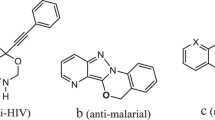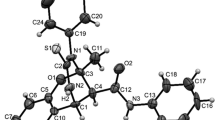Abstract
A series of new natural product skeleton based 3-(halobenzyl)isocarbostyrils (2a–2i), were designed and synthesized to examine the effect of position of different halide substituents on anti-inflammatory activity. The structure–activity relationship shows a significant influence of position of halide substituents on in vitro anti-inflammatory activity. 3-(o-halobenzyl)isocarbostyrils (2a, 2d, and 2g) showed the lowest activity most probably due to the closure of pharmacophore site by intramolecular hydrogen bond between halides and N–H of amide. In contrast, 3-(p-halobenzyl)isocarbostyrils 2c, 2f, and 2i exhibited moderate to very good inflammatory activity. Compound 2c (IC50 = 251.002 ± 2.910) was found to have comparable activity with the standard drug (Indomethacin, IC50 = 271.210 ± 2.127). To further understand the effect of position of halide substituents on 3-(halobenzyl)isocarbostyrils, computational POM was carried out. The study with constructive propositions may be helpful for the design of more potent analogs.
Graphical Abstract








Similar content being viewed by others
References
Abid OUR, Babar TM, Ali FI, Ahmed S, Wadood A, Rama NH, Uddin R, Zaheer-ul-Haq, Khan A, Choudhary MI (2010) Identification of novel urease inhibitors by high-throughput virtual and in vitro screening. ACS Med Chem Lett 1:145–149
Ali FI, Babar TM, Rama NH, Jones PG (2010) 3-(3-Bromobenzyl)isoquinolin-1(2H)-one. Acta Crystallogr E 66:O16–O1225
Aly Y, Galal A, Wong LK, Fu EW, Lin FT, Duah FK, Schiff PL (1989) A revision of the structure of the isoquinolone alkaloid thalflavine. Phytochem 28:1967–1971
Asano Y, Kitamura S, Ohra T, Itoh F, Kajino M, Tamura T, Kaneko M, Ikeda S, Igata H, Kawamoto T, Sogabeb S, Matsumotob S, Tanakab T, Yamaguchib M, Kimurab H, Fukumoto S (2008) Discovery, synthesis and biological evaluation of isoquinolones as novel and highly selective JNK inhibitors (2). Bioorgan Med Chem 16:4699–4714
Assarzadeh MJ, Almasirad A, Shafiee A, Koopaei MN, Abdollahi M (2014) Synthesis of new thiazolo[3,2-b][1,2,4]triazole-6(5H)-one derivatives as potent analgesic and anti-inflammatory agents. Med Chem Res 23:948–957
Bansal Y, Sethi P, Bansal G (2013) Coumarin: a potential nucleus for anti-inflammatory molecules. Med Chem Res 22:3049–3060
Clark DE (1999) Rapid calculation of polar molecular surface area and its application to the prediction of transport phenomena. 1. Prediction of intestinal absorption. J Pharm Sci 88:807–814
Coelho F, Veronese D, Lopes ECS, Rossi RC (2003) An approach to substituted dihydroisoquinolin-1(2H)-ones from Baylis–Hillman adducts. Tetrahedron Lett 44:5731–5735
Ertl P, Rohde B, Selzer P (2000) Fast calculation of molecular polar surface area as a sum of fragment-based contributions and its application to the prediction of drug transport properties. J Med Chem 43:3714–3717
Gasteiger J, Hutchings MG, Marsili M, Saller H (1985) Rapid calculation of electronic effects in organic molecules. In: Seydel JK (ed) QSAR and strategies in the design of bioactive compounds. VCH-Verlagsgesellschaft, Weinheim, pp 90–97
Glushkov VA, Shklyaev YV (2001) Synthesis of 1(2H)-isoquinolones (review). Chem Heterocycl Compd 37:663–687
Guastavino JF, Barolo SM, Rossi RA (2006) One-pot synthesis of 3-substituted isoquinolin-1-(2H)-ones and fused isoquinolin-1-(2H)-ones by SRN1 reactions in DMSO. Eur J Org Chem: 3898–3902
Heaney H, Shuhaibar KF (1995) New routes to acyliminium ion precursors and a synthesis of the nuevamine skeleton. Synlett 1995:47–48
Henson PM, Murphy RC (1989) Mediators of the inflammatory process, 6th edn. Elsevier, Amsterdam
Hudlicky T, Rinner U, Gonzalez D, Akgun H, Schilling S, Siengalewicz P, Martinot TA, Pettit GR (2002) Total synthesis and biological evaluation of amaryllidaceae alkaloids: narciclasine, ent-7-deoxypancratistatin, regioisomer of 7-deoxypancratistatin, 10b-epi-deoxypancratistatin, and truncated derivatives. J Org Chem 67:8726–8743
Katsori AM, Chatzopoulou M, Dimas K, Kontogiorgis C, Patsilinakos A, Trangas T, Hadjipavlou-Litina D (2011) Curcumin analogues as possible anti-proliferative and anti-inflammatory agents. Eur J Med Chem 46:2722–2735
Kohlhagen G, Paull KD, Cushman M, Nagafuji P, Pommier Y (1998) Protein-linked DNA strand breaks induced by NSC 314622, a novel noncamptothecin topoisomerase I poison. Mol Pharmacol 54:50–58
Krane BD, Shamma M (1982) The isoquinolone alkaloids. J Nat Prod 45:377–384
Li LH, Chua WKS (2011) One-pot multistep synthesis of 3,4-fused isoquinolin-1(2H)-one analogs. Tetrahedron Lett 52:1574–1577
Li SW, Nair MG, Edwards DM, Kisliuk RL, Gaumont Y, Dev IK, Duch DS, Humphreys J, Smith GK, Ferone R (1991) Folate analogs.35. synthesis and biological evaluation of 1-deaza, 3-deaza, and bridge-elongated analogs of N-10-propargyl-5,8-dideazafolic acid. J Med Chem 34:2746–2754
Lipinski CA, Lombardo F, Dominy BW, Feeney PJ (2001) Experimental and computational approaches to estimate solubility and permeability in drug discovery and development settings. Adv Drug Deliv Rev 46:3–26
Lohn M, Plettenburg O, Ivashchenko Y, Kannt A, Hofmeister A, Kadereit D, Schaefer M, Linz W, Kohlmann M, Herbert JM, Janiak P, O’Connor SE, Ruetten H (2009) Pharmacological characterization of SAR407899, a novel rho-kinase inhibitor. Hypertension 54:676–683
Masferrer JL, Zweifel BS, Manning PT, Hauser SD, Leahy KM, Smith WG, Isakson PC, Seibert K (1994) Selective-inhibition of inducible cyclooxygenase-2 in vivo is antiinflammatory and nonulcerogenic. Proc Natl Acad Sci U S A. 91:3228–3232
Matsui T, Sugiura T, Nakai H, Iguchi S, Shigeoka S, Takada H, Odagaki Y, Nagao Y, Ushio Y, Ohmoto K, Iwamura H, Yamazaki S, Arai Y, Kawamura M (1992) Novel 5-HT3 antagonists—isoquinolinones and 3-aryl-2-pyridones. J Med Chem 35:3307–3319
Mokrosz MJ, Mokrosz JL, Duszynska B, DerenWesolek A, Klodzinska A, Kowalski P, Charakchieva-Minol S, Tatarczyńska E, Kowalska T, Majka Z, Chojnacka-Wójcik E, Misztal S (1997) 5-HT1A and 5-HT2A receptor affinity and functional profile of some N-[3-(4-aryl-1-piperazinyl)propyl] derivatives of indolin-2(1H)-one, quinolin-2(1H)one and isoquinolin-1(2H)-one.30. Structure-activity relationship studies of CNS agents. Pharmazie 52:423–428
Mor M, Rivara S, Pala D, Bedini A, Spadoni G, Tarzia G (2010) Recent advances in the development of melatonin MT1 and MT2 receptor agonists. Exp Opin Ther Pat 20:1059–1077
Ouchi H, Kawata Y, Ono M, Morita Y, Yamamoto Y, Takahata H (2004) Regioselective aromatic substitution of 6,8-dihydroxy-4-ethoxycarbonyl-2H-isoquinolin-1-one derivatives using the stille coupling reaction. Heterocycles 62:491–501
Paramashivappa R, Kumar PP, Rao PVS, Rao AS (2003) Design, synthesis and biological evaluation of benzimidazole/benzothiazole and benzoxazole derivatives as cyclooxygenase inhibitors. Bioorg Med Chem Lett 13:657–660
Pettit GR, Meng YH, Herald DL, Graham KAN, Pettit RK, Doubek DL (2003) Isolation and structure of ruprechstyril from Ruprechtia tangarana. J Nat Prod 66:1065–1069
Polisson R (1996) Nonsteroidal anti-inflammatory drugs: practical and theoretical considerations in their selection. Am J Med 100:31S–36S
Rajakumar P, Anandhan R (2011) Synthesis and in vitro anti-inflammatory activity of novel glycodendrimers with benzene 1,3,5 carboxamide core and triazole as branching unit. Eur J Med Chem 46:4687–4695
Rajakumar P, Rasheed AMA, Rabia AI, Chamundeeswari D (2006) Synthesis and study of anti-inflammatory activity of some novel cyclophane amides. Bioorg Med Chem Lett 16:6019–6023
Rigby JH, Maharoof USM, Mateo ME (2000) Studies on the narciclasine alkaloids: total synthesis of (+)-narciclasine and (+)-pancratistatin. J Am Chem Soc 122:6624–6628
Shafi S, Alam MM, Mulakayala N, Mulakayala C, Vanaja G, Kalle AM, Pallu R, Alam MS (2012) Synthesis of novel 2-mercapto benzothiazole and 1,2,3-triazole based bis-heterocycles: their anti-inflammatory and anti-nociceptive activities. Eur J Med Chem 49:324–333
Siddiqui RA, English D, Harvey K, Cui Y, Martin MI, Wentland J, Akard L, Jansen J, Thompson J, Garcia JGN (1995) Phorbol ester-induced priming of superoxide generation by phosphatidic acid-stimulated neutrophils and granule-free neutrophil cytoplasts. J Leukoc Biol 58:189–195
Simonsen KB, Juhl K, Steiniger-Brach B, Nielsen SM (2010) Novel NK3 receptor antagonists for the treatment of schizophrenia and other CNS indications. Curr Opin Drug Discov Devel 13:379–388
Snow RJ, Cardozo MG, Morwick TM, Busacca CA, Dong Y, Eckner RJ, Jacober S, Jakes S, Kapadia S, Lukas S, Panzenbeck M, Peet GW, Peterson JD, Prokopowicz AS 3rd, Sellati R, Tolbert RM, Tschantz MA, Moss N (2002) Discovery of 2-phenylamino-imidazo[4,5-h]isoquinolin-9-ones: a new class of inhibitors of lck kinase. J Med Chem 45:3394–3405
Sugimoto A, Shinbatanaka H, Ishikawa M (1995) A new synthetic route to isoquinolin-1(2h)-one derivatives from 3-hydroxyphthalides. Synthesis: 431–434
Tan AS, Berridge MV (2000) Superoxide produced by activated neutrophils efficiently reduces the tetrazolium salt, WST-1 to produce a soluble formazan: a simple colorimetric assay for measuring respiratory burst activation and for screening anti-inflammatory agents. J Immunol Methods 238:59–68
Tonk RK, Bawa S, Chawla G, Deora GS, Kumar S, Rathore V, Mulakayala N, Rajaram A, Kalle AM, Afzal O (2012) Synthesis and pharmacological evaluation of pyrazolo[4,3-c]cinnoline derivatives as potential anti-inflammatory and antibacterial agents. Eur J Med Chem 57:176–184
Tyagi V, Khan S, Giri A, Gauniyal HM, Sridhar B, Chauhan PMS (2012) A ligand-free Pd-catalyzed cascade reaction: an access to the highly diverse isoquinolin-1(2H)-one derivatives via isocyanide and Ugi-MCR synthesized amide precursors. Org Lett 14:3126–3129
Viswanadhan VN, Ghose AK, Revankar GR, Robins RK (1989) Atomic physicochemical parameters for 3 dimensional structure directed quantitative structure–activity relationships. 4. Additional parameters for hydrophobic and dispersive interactions and their application for an automated superposition of certain naturally-occurring nucleoside antibiotics. J Chem Inf Comput Sci 29:163–172
Wang F, Liu HX, Fu H, Jiang YY, Zhao YF (2009) An efficient one-pot copper-catalyzed approach to isoquinolin-1(2H)-one derivatives. Org Lett 11:2469–2472
Waring MJ, Ben-Hadda T, Kotchevar AT, Ramdani A, Touzani R, Elkadiri S, Hakkou A, Bouakka M, Ellis T (2002) 2,3-bifunctionalized quinoxalines: synthesis, DNA interactions and evaluation of anticancer, anti-tuberculosis and antifungal activity. Molecules 7:641–656
Wu F, Büttner FH, Chen R, Hickey E, Jakes S, Kaplita P, Kashem MA, Kerr S, Kugler S, Paw Z, Prokopowicz A, Shih CK, Snow R, Young E, Cywin CL (2010) Substituted 2H-isoquinolin-1-one as potent Rho-Kinase inhibitors. Part 1: hit-to-lead account. Bioorg Med Chem Lett 20:3235–3239
Zhu F, Lin YC (2006) Marinamide, a novel alkaloid and its methyl ester produced by the application of mixed fermentation technique to two mangrove endophytic fungi from the South China Sea. Chin Sci Bull 51:1426–1430
Acknowledgments
The authors are grateful to the Higher Education Commission (HEC) of Pakistan for financial support.
Author information
Authors and Affiliations
Corresponding author
Rights and permissions
About this article
Cite this article
Babar, T.M., Naseer, M.M., Ali, F.I. et al. Synthesis and effect of substituent position on anti-inflammatory activity of 3-(halobenzyl)isocarbostyrils. Med Chem Res 23, 4607–4618 (2014). https://doi.org/10.1007/s00044-014-1027-8
Received:
Accepted:
Published:
Issue Date:
DOI: https://doi.org/10.1007/s00044-014-1027-8




